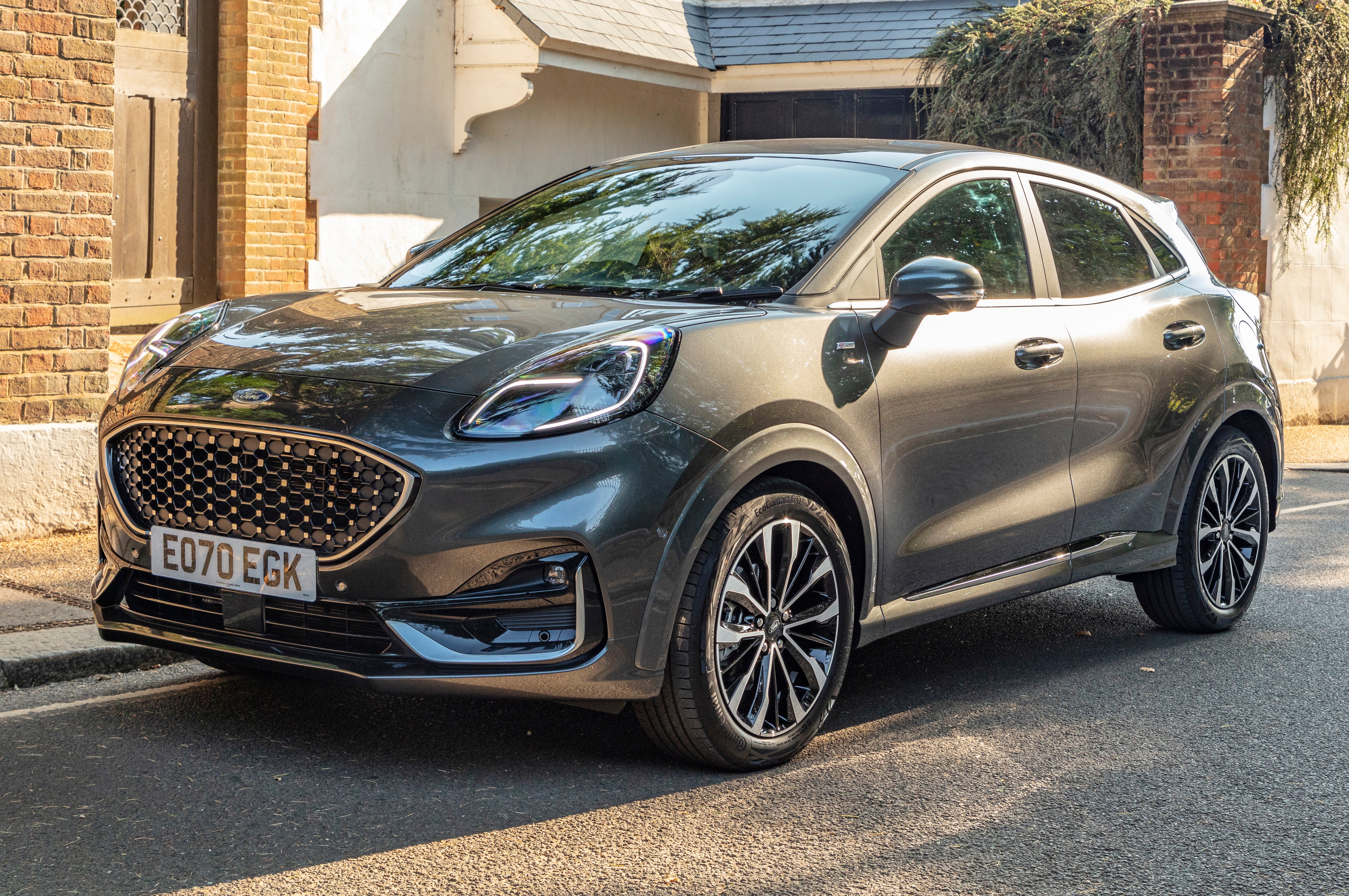Ford Puma Review 2025: Price, specs & boot space
Written by Andrew Brady
Quick overview
Pros
- Peppy engines and sharp handling
- Practical boot with impressive ‘megabox’
- All versions are loaded with standard equipment
Cons
- Not as spacious inside as some alternatives
- A Skoda Kamiq rides better
- Lots of wind noise at higher speeds
Verdict: Is the Ford Puma a good car?
"With frisky engines, sharp styling and impressive kit levels, the Ford Puma sits proudly at the top of the small SUV sector."
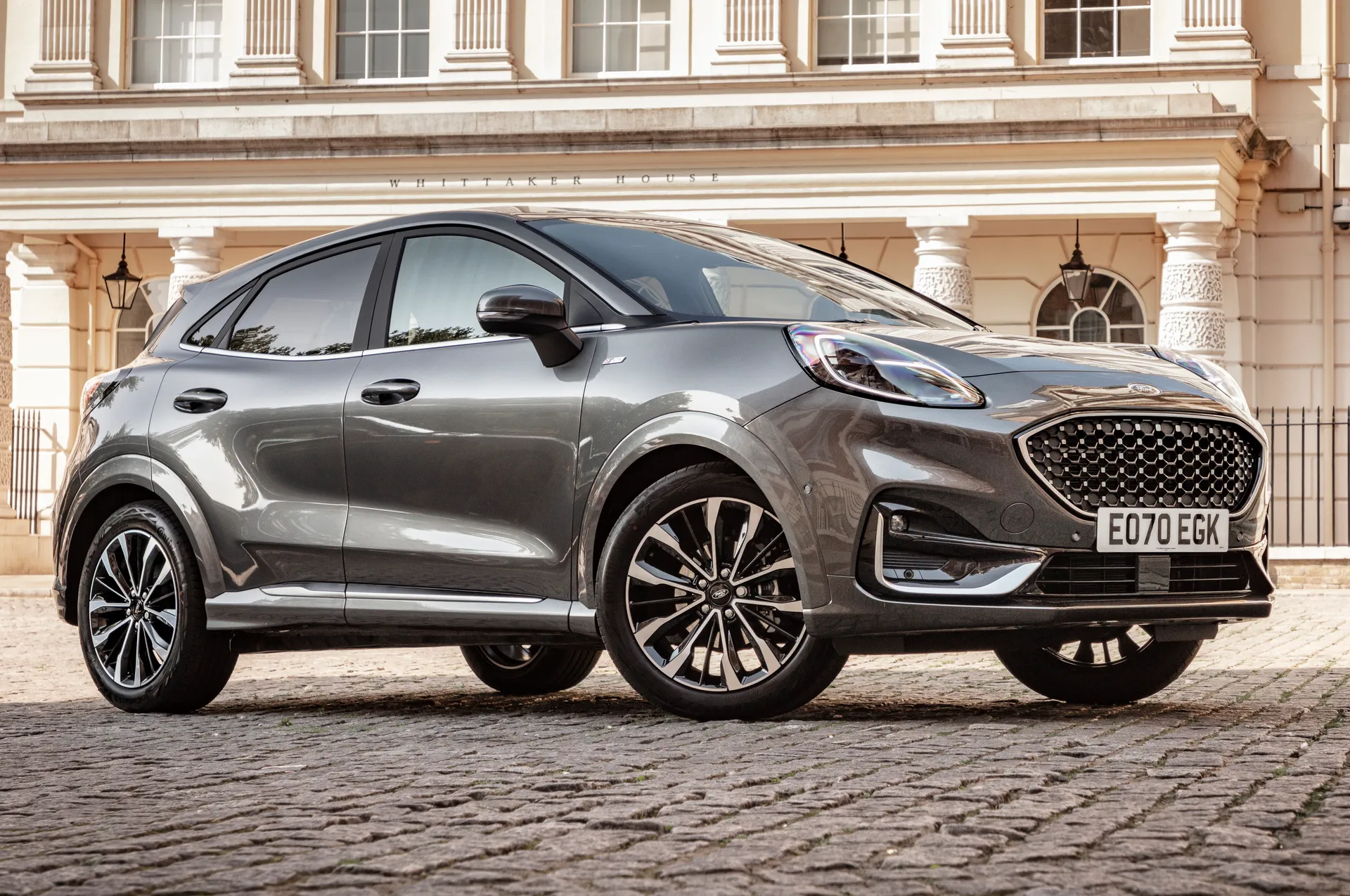
You don't need to be an expert in small SUVs to have noticed the Ford Puma: they're simply everywhere. Indeed, it's currently one of the nation's best-selling cars. And for good reason. It's one of the best small cars on sale today, and it won't cost a lot to buy or run. Read our full 2025 Ford Puma review to find out why it should be high on your shortlist.
Ford first dangled its toes into the small SUV market with the disappointing EcoSport way back in 2014. To say it fell wide of the mark is an understatement: it was ugly, frustrating to drive and had a naff interior. The Puma was Ford's second attempt and, frankly, it's every bit as good as the EcoSport was rubbish.
Based on the popular Ford Fiesta hatchback, the Ford Puma has the edge on even the very best of the competition. We're talking cars like the Nissan Juke, Skoda Kamiq, Volkswagen T-Roc, Renault Captur, Peugeot 2008 and Toyota Yaris Cross. You name it, the Puma's probably better than it.
Initially only sold with the 1.0-litre EcoBoost petrol engine, Ford Puma buyers could decide how much power they wanted: 125PS or 155PS. Both were offered with mild-hybrid technology, while the lower-powered engine was also sold without.
A 1.0-litre engine might sound a little weedy but, actually, the Ford Puma packs plenty of punch. It’s a lot more fun to drive than something like a Nissan Juke or Volkswagen T-Roc, yet also ticks the boxes for comfort and refinement when you want to take it on a long journey.
And if you want proof of Ford's confidence in the Puma, they have even developed a high-performance version in the form of the Ford Puma ST. Initially, power came from the same 1.5-litre turbocharged three-cylinder petrol engine as the Ford Fiesta ST, producing 200PS and giving the Puma the zip to go with the looks. Later on, that engine was switched out for a 170PS version of the 1.0-litre.
The Puma was given a facelift in 2024, with a few minor exterior changes, a revised level of tech and a new steering wheel inside.
The Ford Puma is a bit smaller than many rivals, and that means it’s not quite as spacious as alternatives inside. Your kids would probably prefer it if you bought a Renault Captur.
It has got an ace up its sleeve, though. The Ford Puma's boot space is huge at 456 litres, partly thanks to a clever feature hidden underneath the boot floor. It’s essentially a plastic-lined (and so wipe-clean) 80-litre storage area dubbed the ‘megabox’. There's also a drain plug in the bottom for when you want to wash it out. It might not sound that innovative, but it's super-useful for carrying things like muddy football boots.
You can’t really buy a basic Ford Puma, which explains why it looks relatively expensive on the used market. The most affordable models are badged Ford Puma Titanium, meaning you get things like cruise control, an 8.0-inch navigation system and rear parking sensors. Massage seats, too. Yup, on the entry-level car.
Most people will be tempted by the sportier Ford Puma ST-Line or Ford Puma ST-Line X models, while early cars were also offered with Ford Puma First Edition packs. Depending on trim level, these add features like extra driver assistance features or a panoramic sunroof.
As you can probably tell, we rate the Ford Puma highly. The main issue is that demand is so high that you're not going to have a great deal of luck if you visit your nearest Ford dealer expecting a huge saving over list price on a nearly-new or pre-reg model. There are still some deals out there though: check out our latest best new car deals for more. Otherwise, we've got 100s of Ford Approved Used Cars for Sale for you to choose from, including a wide range of Ford Puma cars for sale.
Is the Ford Puma right for you?
Do you want one of the most desirable small SUVs on sale? Silly question. The Ford Puma ticks a lot of boxes for a lot of people. As well as being great to drive, it’s a comfortable choice that’ll happily eat up motorway miles. It’s got more personality than the Volkswagen T-Roc, and is better to drive than a Citroen C3 Aircross. Frankly, it’s in a different league to the Vauxhall Mokka.
Okay, the cabin could be a little roomier, and some people will turn their noses up at the Ford badge. At motorway speeds there's more wind noise than we'd want, too. But other than that, there’s really not an awful lot going against the Ford Puma.
What other cars are similar to the Ford Puma?
We’d suggest looking at the Volkswagen T-Roc as a rival to the Ford Puma. It’s a stylish small SUV with a decent cabin (although it feels a bit cheap in some areas). The SEAT Arona is better to drive and has been around for longer, so you’re more likely to find a pre-loved bargain. For an extra layer of premium appeal, check out the Lexus LBX.
We like the latest Peugeot 2008, although the Renault Captur is a more practical choice, while the Citroen C3 Aircross majors on comfort. If you’re on a budget, you could also consider the Ford EcoSport. But we wouldn’t recommend it.
Thinking of going electric? Well, there's an all-electric version of the Puma, called the Ford Puma Gen-E. Otherwise, the MINI Aceman is well worth a look, as are the Skoda Elroq, Volvo EX30 and Hyundai Kona Electric, and several more as well. In short, if there's such as thing as a golden age of small SUVs, we're in it.
Comfort and design: Ford Puma interior
"There’s nothing revolutionary about the Ford Puma’s interior design. It looks an awful lot like the old Ford Fiesta's, particularly up front. A Peugeot 2008 is more stylish inside, while we rate the Volkswagen T-Roc’s minimalist (if a little dull) approach."
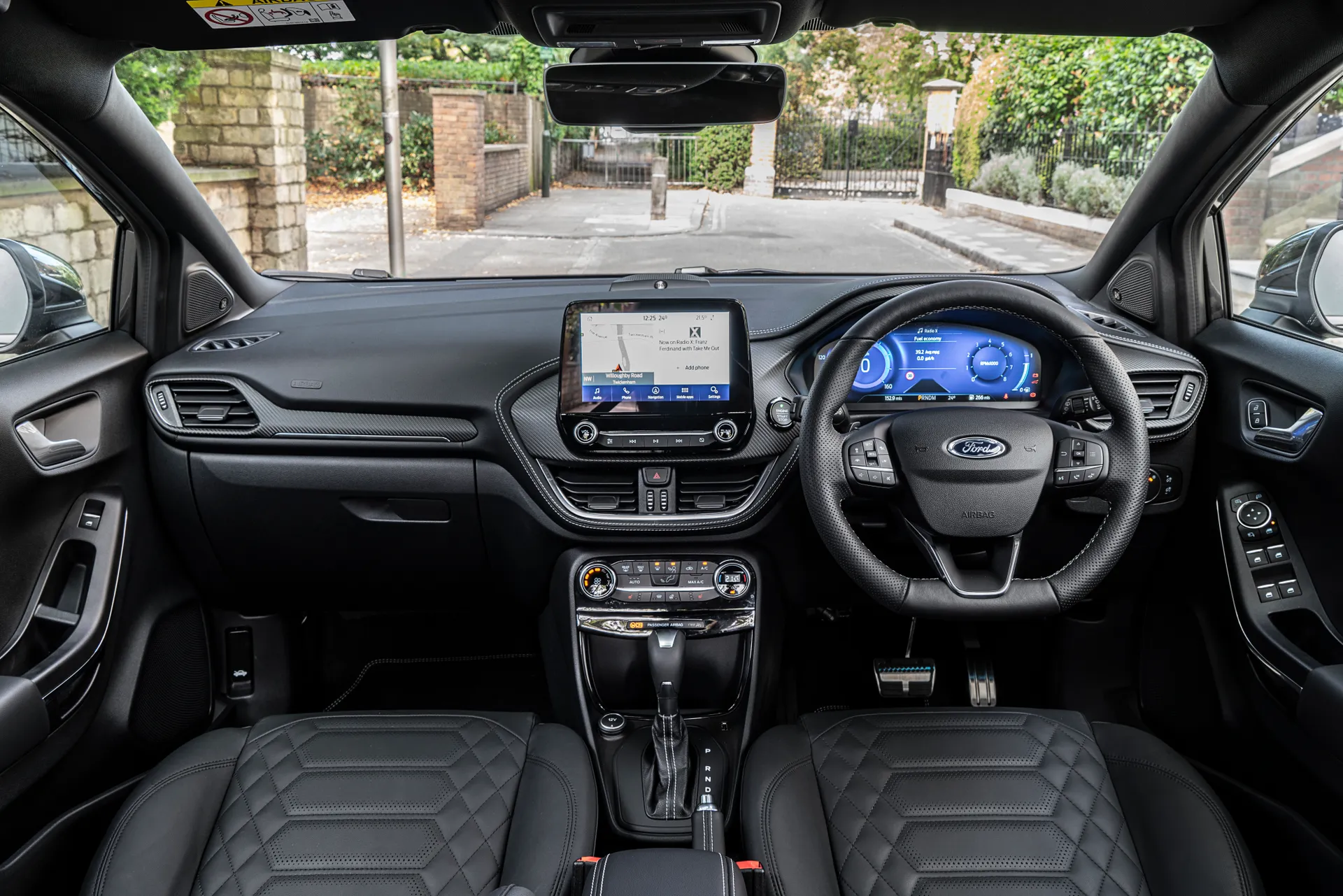
Fortunately, Ford interiors have improved dramatically in recent years, so don’t dismiss the Ford Puma on the basis that a Ford Focus you drove a few years ago felt a little naff inside. Pre-facelift models get a meaty-feeling steering wheel, while there’s a sensible amount of buttons dotted around, but without feeling overwhelming.
The 2024 facelift brought with it a new square steering wheel that we'll get onto in the driving impressions section below, as well as a much larger infotainment screen that takes over the duties of just about everything. We'll get into that in the infotainment section below.
All Ford Pumas come with a height-adjustable driver’s seat along with adjustable lumbar support. This, combined with plenty of movement in the steering wheel, means drivers of all shapes and sizes should be able to get comfortable. Being slightly higher than something like a Ford Fiesta, you’ll also find access easy: you can slide onto the driver’s seat rather than down into it.
In a slightly weird quirk, the most affordable Ford Puma Titanium models come with massage seats for the driver and front passenger, but these aren’t available on Ford Puma ST-Line models. The ST-Line does get sport seats with a little more side support, while the Ford Puma ST-Line X comes with part-leather seats.
Look for models fitted with the Comfort Pack (standard on Titanium First Edition models) for heated seats and steering wheel. The optional panoramic sunroof is another desirable option that makes the cabin feel a little brighter.
Quality and finish
Don’t go expecting a premium finish from the Ford Puma: there are a few hard plastics here and there to remind you that you’re driving a Ford rather than a more expensive alternative. No more than what you’d find in the Volkswagen T-Roc, though, and it’s a lot better than in the old budget-focused Ford EcoSport.
Ford Puma ST-Line X models come with part-leather seats and carbon-effect trim, both of which help make the cabin feel a bit more special, but it’s still not the plushest small SUV on the market.
The switchgear feels robust but it’s not going to make you feel as warm and fuzzy as a premium rival like the Audi Q2. Still, you don’t buy a Ford Puma to get a warm and fuzzy feeling from the switches.
Infotainment: touchscreen, USB, nav and stereo in the Ford Puma
Pre-facelift Ford Pumas all have the same 8.0-inch infotainment system perched on top of the dashboard, like a bit of an afterthought. Its positioning might look a bit awkward but it’s well-placed for glancing at while driving.
This provides access to all the features you’d expect: navigation, DAB radio, Bluetooth, Apple CarPlay and Android Auto. It’s a simple system to use with logical menu layouts and clear graphics. Sometimes it can feel a little laggy to respond, but it’s a much better system than that found in rivals like the DS 3 Crossback and Peugeot 2008.
Want more tech? Ford Puma ST-Line and Puma ST-Line X models had a fancy 12.3-inch digital instrument cluster. Some Titanium models will have it, too, as part of the Technology Pack. It replaces traditional dials with a TFT screen with a layout that can be modified. It’s no Audi Virtual Cockpit, but it still looks pretty sharp.
Finally, there are two USB ports in the front along with a wireless charging pad. Your phone isn’t going to run out of charge in a Ford Puma.
From 2024, the facelifted Puma got an overhauled infotainment system with a much bigger 12.0-inch central display, as well as a 12.8-inch digital driver display behind the revised steering wheel. Most of the dashboard buttons have gone, so everything from air-con to the rear-screen heater is controlled through the touchscreen. While this undoubtedly makes the Puma's cabin look smarter and less cluttered, it makes it much more difficult and time-consuming to adjust things, especially on the move. However, the software itself works well, and it responds quickly. As well as Apple CarPlay and Android Auto, it also has Amazon Alexa built-in. Overall, it's an aesthetic improvement, but harder to use than the system that preceded it.
Space and practicality: Ford Puma boot space
The Ford Puma is one of the smallest of the small SUVs, measuring just under 4.2m long and a touch over 1.8m wide, yet it’s also one of the most practical.
We’ll start with the Ford Puma's boot space, because that contains one of the Ford Puma’s most exciting features. If you’re the kind of person who finds practicality exciting, that is. We do.
As well as having a big boot with usefully square dimensions and a wide opening, the Ford Puma’s hiding an extra 80 litres of luggage space under the floor take the total boot space of the Ford Puma up to 456 litres. This is in the form of a what Ford calls a ‘megabox’ (told you it was exciting…). It’s essentially a square underfloor load area with a heard-wearing plastic lining and a drain plug at the bottom so you can hose it clean. Great for carrying plants home from the garden centre.
On the downside, the megabox means there’s nowhere to store a spare wheel (and Ford’s resisted the temptation to stick it on the back like the original Ford EcoSport). However, not having a spare isn't exactly rare these days.
Unlike the Renault Captur and Volkswagen T-Cross, there’s no sliding rear bench in the Ford Puma. That’s no biggy, though, and the rear bench does drop easily to provide more luggage space if required.
Space in the back feels pretty tight, especially for adults. Head- and legroom is limited and the shape of the rear windows means it feels a little claustrophobic. ISOFIX points are fitted to the outer rear seats, helping to secure child seats. They’re not present on the front passenger seat, though.
Things are better up front, where the driver and front-seat passenger will find plenty of room. There’s loads of space for all your knick-knacks, too, with decent door bins and a pretty big glovebox. The cupholders in the centre console are useful, although you’ll have to be careful not to spill your coffee while circumventing the handbrake.
Finally, just a note on the panoramic sunroof (available as an option across the range). While we love a panoramic roof for letting extra light into the cabin, it does eat into headroom slightly. Think twice if you’re a taller person.
Handling and ride quality: What is the Ford Puma like to drive?
"You don’t need to be Max Verstappen to appreciate how much fun the Ford Puma is to drive. Just like the Ford Fiesta on which it’s based, it’ll dart around corners with great enthusiasm and little in the way of rolypolyness. Yes, that’s a word."
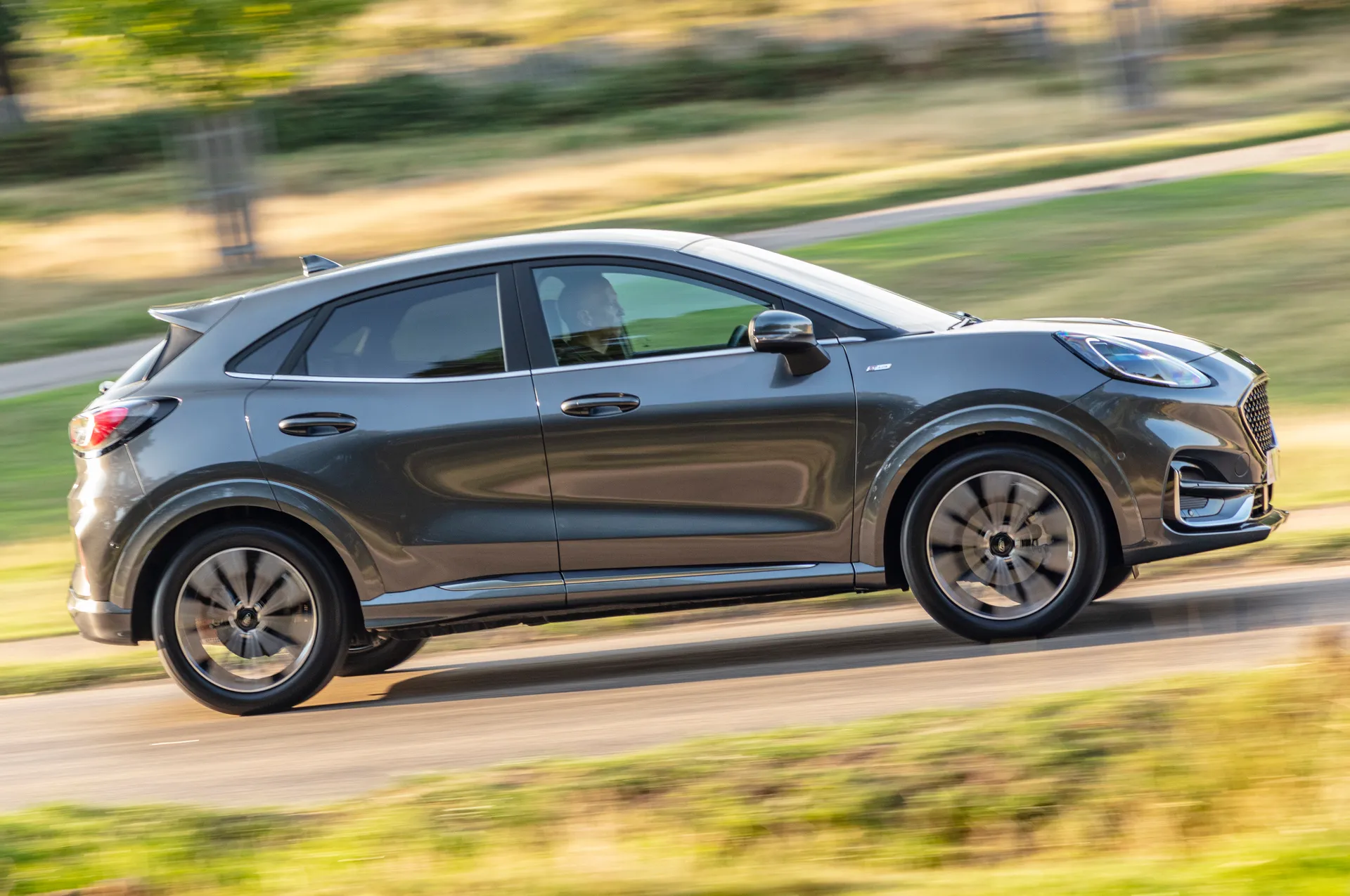
That’s especially true for Ford Puma ST-Line and ST-Line X trim levels with their sports suspension, but all Ford Puma models are dynamically sharper than rivals like the Renault Captur and Skoda Kamiq.
What’s most impressive is that Ford’s combined the Puma’s eager handling with very decent ride comfort: the suspension copes perfectly fine with lumps and bumps in the road, even with the sportier setup of the Ford Puma ST-Line trim levels. Sure, there are softer alternatives (like the Skoda Kamiq), but the Ford Puma proves you can have a great handling car that rides well.
While the Ford Puma’s great fun on a country road, it’ll also cover long motorway journeys quite comfortably, feeling like a much bigger, more grown-up car than it is. The high-up seating position (compared to a Ford Fiesta) also helps here.
That also helps around town, where you get a good view over traffic ahead. The Ford Puma’s responsive steering and precise manual gear change makes it a joy to bimble about in. Reversing sensors (and a rear-view camera on high-spec models) help with parking.
All Ford Pumas come with selectable drive modes, ranging from Eco to Sport and Slippery to Trail. While the Ford Puma isn’t available with four-wheel drive, the latter modes do a great job of making up for that in snowy or slippery conditions. Combine this with winter tyres and we reckon you’re onto a winner when Jack Frost hits. Sport mode, meanwhile, livens up the (already quite responsive) throttle response and adds a bit of weight to the steering.
Speaking of the steering, the facelift in 2024 brought a new, large and rather square steering wheel. While we didn't find it too much of an issue, it's definitely a bit different to the controls in rival cars, and we've heard from others that found it unwieldy. It's one of those features that make a test-drive a good idea before you buy.
What engines and gearboxes are available in the Ford Puma?
Is a 1.0-litre engine not a bit weedy in a car like the Ford Puma? You might be surprised. The more powerful 155PS models are particularly punchy, helped by the mild-hybrid system, which is fitted as standard.
This isn’t a ‘proper’ hybrid like a Toyota C-HR, nor do you have to plug it in like the Mitsubishi Outlander PHEV. It can’t run entirely under electric power alone: rather, the small battery and electric motor will give the petrol engine a helping hand, providing a small power boost and a minor improvement in efficiency. You can really feel the extra low-down oomph that it provides, especially compared to a regular petrol engine that has to build up revs when you first accelerate.
But acceleration aside, our favourite thing about the Ford Puma mild-hybrid system is that you won’t really otherwise notice it. The more observant driver might spot that the engine turns itself off before you roll entirely to a stop (the electric motor ensures you don’t lose things like steering), but it just works seamlessly, saving you a few quid at the petrol pumps.
Previously, the lower-powered 125PS engine was available with or without the mild-hybrid system, but it now comes as standard. Most used Pumas have it anyway, but it makes such a negligible difference that it shouldn’t be deal-breaker either way.
Even the Ford Puma 125 Ecoboost is pretty nippy, accelerating to 62mph in around 10 seconds. The 155PS takes 8.9 seconds, meaning it’s a better choice if you like to overtake slower traffic or frequently have to tackle short motorway slip roads.
The Ford Puma was initially only offered with a manual gearbox, so that’s what currently dominates the used market. It’s a slick six-speed transmission that adds to the appeal of the Ford Puma for those of us who enjoy driving, but you may wish to seek out an automatic example if you do a lot of stop-start driving. It's a seven-speed auto that Ford calls Powershift, and while it's not the smoothest 'box around, it's never intrusive in its shifts.
If you're looking for a hot hatch with the practicality of a small SUV, you can buy a Ford Puma ST. Initially, it came with the same 200PS turbocharged engine as the Fiesta ST. You can read our thoughts here but, spoiler alert: it's fantastic. This engine was later replaced by a 170PS version of the 1.0-litre, which we've not yet tried. There's also an electric version of the Puma, called the Puma Gen-E, which we're also yet to drive.
Refinement and noise levels
A downside of punchy little three-cylinder engines like those used in the Ford Puma is usually a lack of refinement compared to bigger engines. They can often sound quite coarse, especially at high revs, and they usually need working quite hard.
And yes, there’s certainly a distinctive three-cylinder sound from the Ford Puma as you build the revs, but it’s actually quieter and more refined than you might expect, and at higher speed, the engines settle down well, making the Puma into a surprisingly grown-up long-distance cruiser.
Having said that, you’ll notice a bit of road noise, especially in cars fitted with the bigger 18- or 19-inch alloy wheels. The Ford Puma’s bulky dimensions compared to the Fiesta means there’s a bit of wind noise, too. It’s not particularly intrusive until you get to the top end of motorway speeds, when there's a fair amount of buffeting around the B-pillar, which is right next to the driver's head. Best just crank up the sound system.
While conventional petrol engines with stop/start create a noticeable shudder as the car comes to a halt (and when you pull away again), the Ford Puma’s mild-hybrid system does this on the move, so is less noticeable.
Unlike a proper hybrid, though, it can’t travel under electric power alone. The Toyota C-HR is good at this, providing impressive refinement as it covers short distances around town under electric power alone.
Safety equipment: How safe is the Ford Puma?
The Ford Puma is a very safe car, with Euro NCAP (the independent body responsible for crash-testing new cars) awarding it a maximum five-star safety rating.
It scored well across the board: 94% for adult occupants, 84% for children, 77% for vulnerable road users and 74% for its safety assist systems.
Pleasingly, all Ford Puma models come with a heap of the latest safety technology systems as standard. This includes a pre-collision assist system with autonomous emergency braking, which means that, if the car’s cameras and sensors detect an impending collision, it can apply the brakes automatically to prevent it (or, at least, mitigate the impact).
There’s also a lane-departure warning, which will alert the driver if they start straying out of their lane on the motorway, while hill-start assist will prevent the car rolling backwards during a hill-start manoeuvre.
If you are in a crash and it’s heavy enough for the airbags to deploy, Ford’s infotainment system will automatically use your connected phone to dial the emergency services and will pass on your GPS location.
Ford Puma ST-Line and ST-Line X models come with rain-sensing wipers as well as automatic headlights with automatic high beam: great for night-time driving.
On the downside, the Ford Puma’s ‘mega box’ means there’s no room for a spare wheel in the boot, so you’ll have to make do with a tyre repair kit if you get a puncture.
MPG and fuel costs: What does a Ford Puma cost to run?
"If you’re expecting a big saving in fuel costs for Ford Puma mild-hybrid models, you’re going to be disappointed. Officially, the Ford Puma 125 MHEV model returns 51.4mpg, while the 155 version achieves 50.4mpg. The entry-level 125 Ecoboost engine (without mild-hybrid tech) returns 48.7mpg."
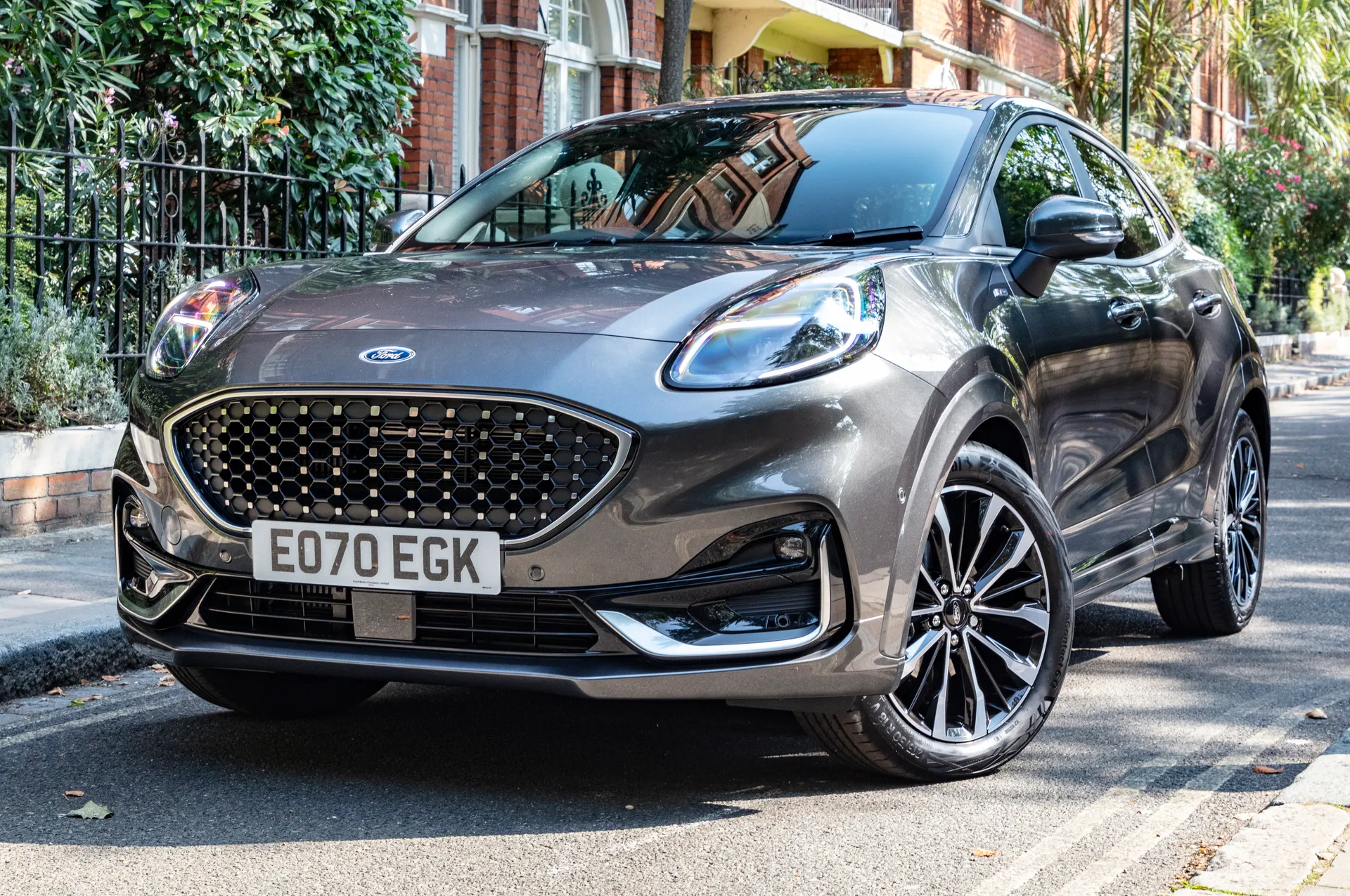
These are figures from the latest WLTP fuel economy tests, which means they ought to be fairly realistic in the real-world. Traditionally, small turbocharged engines like the Ford Ecoboost units aren’t as efficient as you might expect, though.
Ford Puma reliability and warranty
Traditionally, Ford tends to have a decent record on reliability, but that's not necessarily reflected in the latest edition of the HonestJohn.co.uk Satisfaction Index. The 2025 study puts the brand in 26th place for reliability, out of 33 carmakers considered.
There were three Ford models included in the list of the 20 least reliable cars in the study, one of which was the Fiesta that the Puma shares its underpinnings with. The Puma itself didn't feature, though, so take that as a positive.
Ford Puma insurance groups and costs
The standard Ford Puma Ecoboost 125 should be the cheapest to insure. Ford Puma Titanium models with this engine fall into group 11, which is comparable to like-for-like rivals (although you can get less powerful alternatives of rivals, which will cost less in insurance). Sportier Ford Puma ST-Line models and mild-hybrids are in insurance group 12, which means they’ll cost a little more to insure. The priciest is the Ford Puma ST, which can go as high as group 22.
VED car tax: What is the annual road tax on a Ford Puma?
The latest VED rules mean all drivers pay a flat rate of road tax regardless of what type of fuel their car uses (previously, there was a flat rate for petrol and diesel cars, a slightly discounted rate for hybrids, while EVs were exempt, but this ended in April 2025). That flat rate currently stands at £195 per year.
Cars that cost over £40,000 when brand new are faced with an additional £425 surcharge for a five-year period, but that doesn't affect any version of the Puma.
Ford Puma price
"Prices for a brand new Ford Puma start at around £27,000 for the most basic model, and rise up to around £35,000 for the poshest, highest-powered examples."
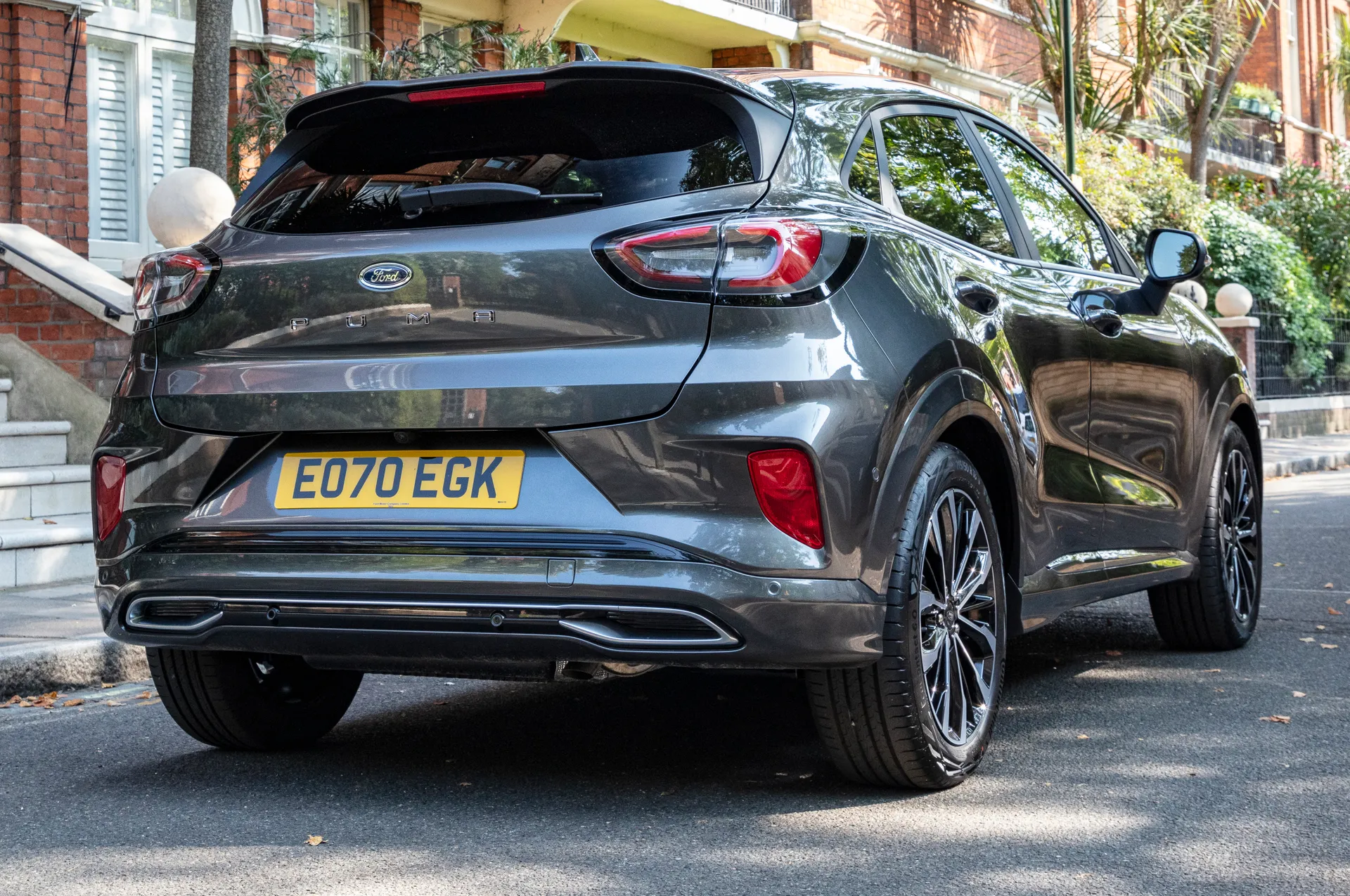
With a number of award wins and glowing reviews across the board, a Ford Puma is a car in demand. Happily, however, being one of the nation's best-selling cars, used car dealers still have plenty of Pumas in stock, with some great deals available for those of us looking to save money over retail price.
Prices for used Pumas start at aroud £10,000-£11,000 on our classifieds. None of these are particularly elderly examples, mostly being around four years old, but many have punched in some quite chunky mileages of around 70,000 miles. However, you don't have to pay too much more for an example with more like 50,000 miles, which is a bit more palatable. A budget of £18,000 will get you a year-old Ford Puma with a low four-digit mileage. That looks like a bit of a steal in our book.
Trim levels and standard equipment
From launch, the Ford Puma range started with the high-spec Titanium model. This is well-equipped with highlights including 17-inch alloy wheels, rear parking sensors and cruise control. Pre-facelift models get Ford’s SYNC3 navigation with an 8.0-inch touchscreen display, while post-facelift models get the larger screen with SYNC4 software and the digital instrument panel.
If you’re after a sporty choice, look for a Ford Puma ST-Line model with its bodykit, rear spoiler and sports suspension. Inside, there’s a flat-bottomed steering wheel (like in a race car) and, on pre-facelift cars, a 12.3-inch digital instrument cluster.
For the ultimate in range-topping sportiness, the Ford Puma ST-Line X adds 18-inch alloy wheels, partial leather trim, rear privacy glass (that’s tinted windows in old money), lumbar and height adjust for the driver and front passenger seats, carbon-look interior highlights and a premium B&O sound system with ten speakers.
These were also offered with additional First Edition packs on early Ford Puma models. Look for a Titanium First Edition for the Driver Assistance and Comfort Packs (the former with such features as a rear-view camera, front parking sensors and adaptive cruise control; the latter with a heated steering wheel and seats). This also adds rear privacy glass.
The Ford Puma ST-Line X First Edition Pack also adds the Driver Assistance Pack as well as LED headlights and an electric tailgate. The ST-Line X was also offered with the First Edition Plus Pack, which had all the highlights of the First Edition Pack in addition to an openable panoramic sunroof and 19-inch alloy wheels.
A number of high-value special edition models have also been offered over time, with weird and wonderful names including the Vivid Ruby Edition, the ST-Line X Gold Edition and the ST-Line Design 2.0.
Ask the heycar experts: common questions
Is the Ford Puma a good car?
Is the Ford Puma bigger than a Fiesta?
What is the Ford Puma based on?
Is the Ford Puma an SUV?
Get our latest advice, news and offers
Keep me updated by email with the latest advice, news and offers from heycar.
By submitting you agree to our privacy policy
